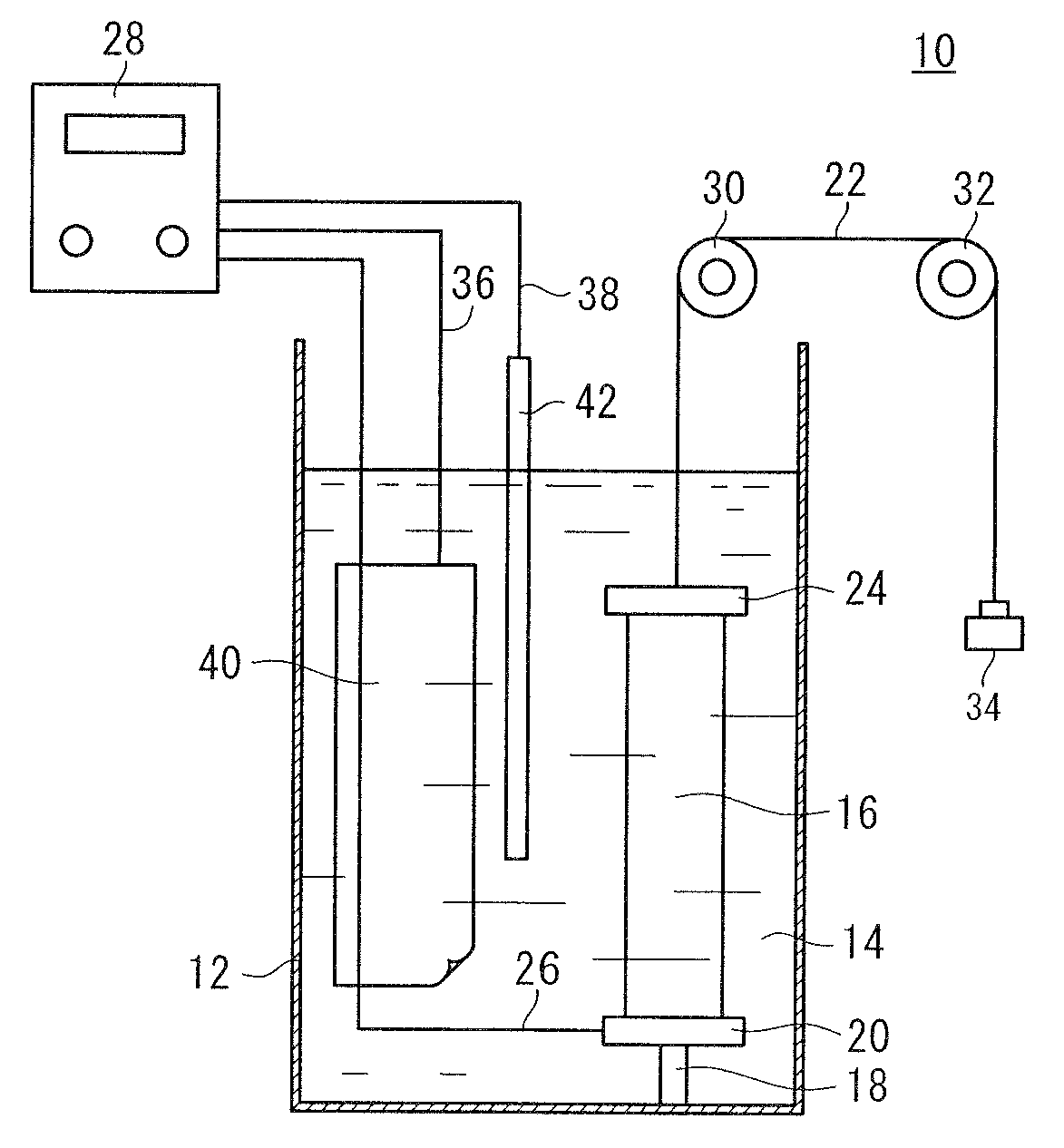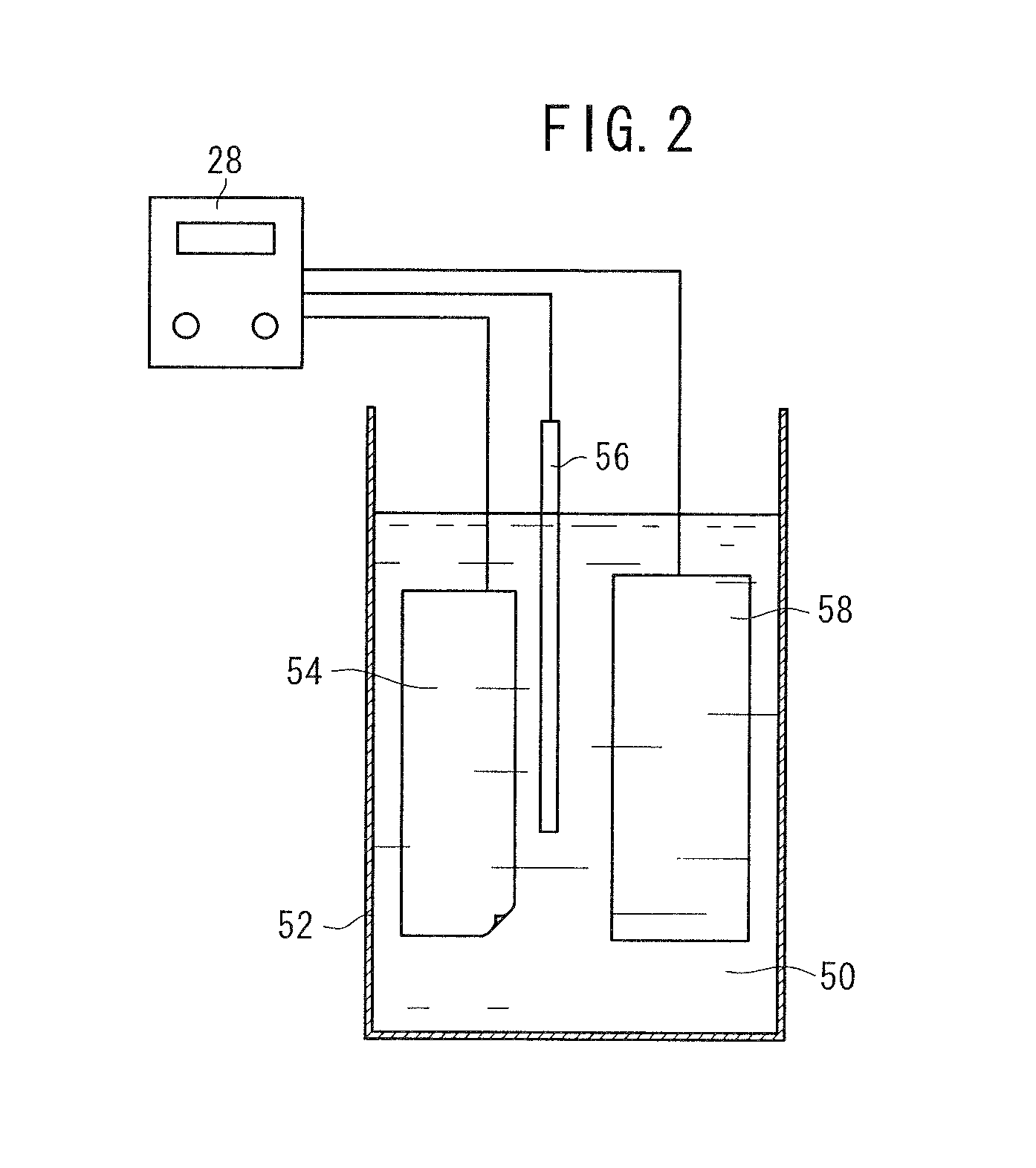Actuator
a technology of actuators and actuators, applied in the field of actuators, can solve problems such as difficulty in maintaining the expansion/contraction ratio, and achieve the effect of high expansion/contraction ratio
- Summary
- Abstract
- Description
- Claims
- Application Information
AI Technical Summary
Benefits of technology
Problems solved by technology
Method used
Image
Examples
example 1
[0061]Pyrrole and p-toluenesulfonate sodium salt were dissolved in pure water at concentrations of 0.3 and 0.2 mol / l respectively, to prepare a polymerization solution. A working electrode of a stainless steel (30 mm×45 mm), a counter electrode of a nickel mesh (50 mm×100 mm), and a reference electrode of Ag / AgCl were electrically connected to a potentiostat, and immersed in the polymerization solution.
[0062]The working electrode and the reference electrode were left at the room temperature (20° C.) for 25 minutes while a voltage of 0.8 V with reference to the reference electrode is applied to the working electrode. The pyrrole was polymerized, so that a 50-μm-thick thin film of a polypyrrole doped with a p-toluenesulfonate ion was deposited on the entire surface of the working electrode.
[0063]The thin film was peeled from the working electrode, and cut into a length of 12 mm and a width of 5 mm. Then, as shown in FIG. 1, the thin film was held by a lower clamp 20 and an upper clamp...
example 2
[0077]Pyrrole and benzenesulfonate sodium salt were dissolved in pure water each at a concentration of 0.2 mol / l, to prepare a polymerization solution. A 50-μm-thick thin film of a polypyrrole doped with a benzenesulfonate ion was deposited on the working electrode in the same manner as Example 1.
[0078]The thin film was peeled from the working electrode, and cut into a length of 8.6 mm and a width of 5 mm. Then, a sweep cycle was repeated plural times in the same manner as Example 1. Changes in the expansion / contraction ratio, the sweep voltage, and the current of the thin film in the sweep cycles are shown in FIG. 7. As shown in FIG. 7, the expansion / contraction ratio was 10% in the fifth cycle, while it was 5% and 6% in the first and third cycles, respectively. Thus, the expansion / contraction ratio was remarkably increased by repeating the sweep cycle five times also in Example 2.
[0079]In addition, as can be seen from FIG. 7, the thin film maintained an expansion / contraction ratio...
example 3
[0080]Pyrrole and p-ethylbenzenesulfonate sodium salt were dissolved in pure water each at a concentration of 0.2 mol / l, to prepare a polymerization solution. A 31-μm-thick thin film of a polypyrrole doped with a p-ethylbenzenesulfonate ion was deposited on the working electrode in the same manner as Examples 1 and 2.
[0081]The thin film was peeled from the working electrode, and cut into a length of 8.9 mm and a width of 5 mm. Then, a sweep cycle was repeated plural times in the same manner as Examples 1 and 2. Changes in the expansion / contraction ratio, the sweep voltage and the current of the thin film in the sweep cycles are shown in FIG. 8. As shown in FIG. 8, the expansion / contraction ratio was 5% in the fifth cycle, while it was 2% and 4% in the first and third cycles, respectively. Thus, the expansion / contraction ratio was increased by repeating the sweep cycle five times also in Example 3.
[0082]As can be seen from FIG. 8, the thin film maintained an expansion / contraction rat...
PUM
| Property | Measurement | Unit |
|---|---|---|
| voltage | aaaaa | aaaaa |
| temperature | aaaaa | aaaaa |
| voltage | aaaaa | aaaaa |
Abstract
Description
Claims
Application Information
 Login to View More
Login to View More - R&D
- Intellectual Property
- Life Sciences
- Materials
- Tech Scout
- Unparalleled Data Quality
- Higher Quality Content
- 60% Fewer Hallucinations
Browse by: Latest US Patents, China's latest patents, Technical Efficacy Thesaurus, Application Domain, Technology Topic, Popular Technical Reports.
© 2025 PatSnap. All rights reserved.Legal|Privacy policy|Modern Slavery Act Transparency Statement|Sitemap|About US| Contact US: help@patsnap.com



